New hikers should prioritize the right gear to guarantee a safe and enjoyable experience. Essential items include sturdy hiking footwear that offers comfort and protection, and a 18-30 liter backpack with adjustable features for balance. Carry navigation tools such as maps and a compass and have a basic first aid kit on hand. Layer clothing to adapt to changing weather conditions, avoiding cotton. For sustenance, bring calorie-dense snacks and plenty of water. These essentials ensure preparedness and enhance the overall experience. For those keen to explore the nuances of hiking gear, a deeper understanding will be greatly beneficial.
Key Takeaways
- Choose durable, waterproof footwear for comfort and protection on varying terrains.
- Carry a first aid kit to address minor injuries and enhance trail safety.
- Use a 18-30 liter backpack for carrying essentials like water, snacks, and clothing.
- Bring navigation tools like a map and compass for reliable direction.
- Wear moisture-wicking socks to prevent blisters and maintain foot health.
Understanding Hike Types
Understanding the various types of hikes is fundamental for selecting the right adventure that aligns with your skill level and personal goals.
Day hikes, which span 3 to 15 miles, are perfect for beginners aiming to enhance their endurance and gain experience. These hikes demand awareness of hike difficulty, as trails can vary greatly. Trail etiquette is essential here—maintain a steady pace, yield to uphill hikers, and leave no trace.
For those with time constraints, half-day hikes offer a 3 to 5-mile journey suitable for families or new hikers. They provide an opportunity to practice trail etiquette in a shorter time frame, guaranteeing a pleasant experience for all hikers.
Full-day hikes, requiring 6 to 12 hours, introduce more challenging conditions and necessitate a higher level of fitness. Thorough preparation and understanding of hike difficulty are critical, as these trails can present varying terrains and weather conditions.
Multi-day hikes are for the seasoned, covering over 10 miles daily. These demand advanced planning and navigation skills.
Planning Your Itinerary
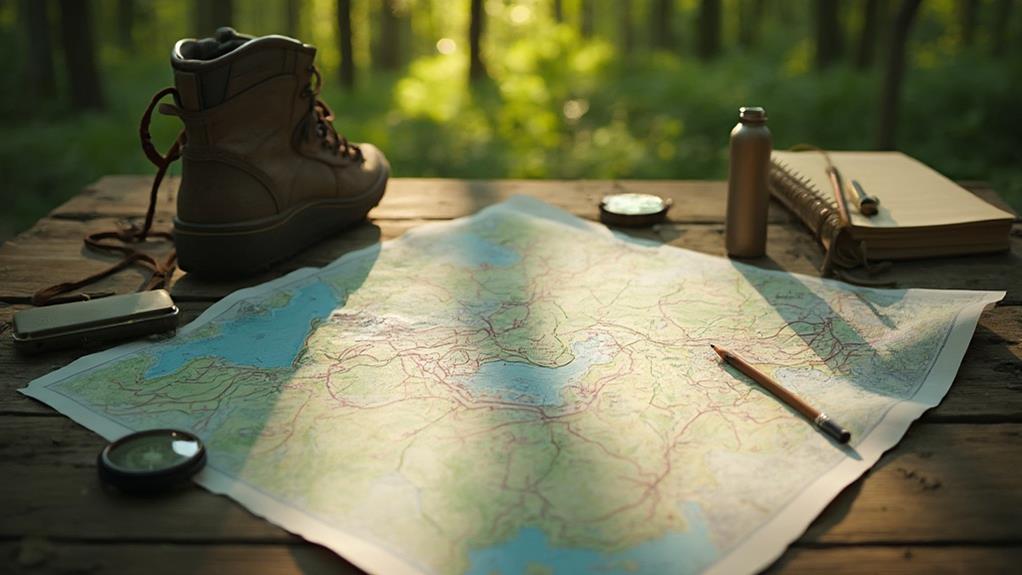
When planning your hiking itinerary, carefully select destinations that align with your fitness level by considering factors such as distance, ascent, and the estimated duration of the hike.
Utilize online resources and guidebooks to gain insights into trail difficulty and any seasonal challenges that could impact accessibility or safety.
To enhance safety, always share your hiking plan, including your route and expected return time, with someone who is not joining the hike.
Choosing Hiking Destinations
Carefully selecting the right hiking destination is essential for guaranteeing both a safe and enjoyable experience. Start by researching local hiking trails using online resources and guidebooks. These tools help identify trails that match your fitness level and experience, considering trail accessibility and any pertinent local regulations. Understanding these factors is critical to avoid unexpected challenges, such as difficult terrain or restricted areas.
When planning your hike, consider the hike's duration, distance, and elevation gain. Matching these elements with your physical capabilities is important to prevent fatigue and guarantee a pleasurable outing. Equally important is checking the trail conditions and any seasonal advisories, which can reveal potential hazards or closures that might affect your plans. By staying informed, you can choose a destination that fits your needs and preferences.
Exploring diverse terrain types, such as forests, mountains, and coastal paths, offers hikers a chance to experience different natural environments. This approach not only enriches the hiking experience but also hones your skills across varied landscapes.
| Factor | Consideration |
|---|---|
| Trail Accessibility | Check for ease of access and regulations |
| Duration | Match with fitness level |
| Distance | Consider your physical capabilities |
| Terrain Type | Explore varied landscapes |
This structured approach guarantees a rewarding hiking adventure.
Sharing Safety Plans
Establishing a thorough safety plan is a critical component of any hiking adventure. The itinerary importance cannot be overstated, as a well-documented plan serves as a roadmap for your hike and a lifeline in case of emergencies.
Begin by drafting a detailed itinerary, outlining your start and expected finish times, along with the specific trail names and starting points. Include any alternative routes you may take to guarantee extensive coverage of your planned path.
It is essential to share this itinerary with a trusted friend or family member who will not be joining you on the hike. This person should also be informed of the number of hikers in your group and any potential hazards you anticipate, such as challenging trail segments or inclement weather conditions.
Establish clear communication protocols, setting a timeline for when you will check in upon your return. If delays or route changes occur, promptly inform your contact to keep them updated on your whereabouts.
These measures not only enhance your safety but also provide peace of mind to both you and your loved ones, ensuring your hiking experience is enjoyable and secure.
Safety First
In the domain of hiking, prioritizing safety is paramount for new adventurers. Adopting proper hiking etiquette and respecting trail maintenance are foundational practices that safeguard both the environment and hikers.
Always inform someone of your hiking plans, including your intended route and return time. This guarantees someone can alert authorities if you do not return as scheduled—a critical precaution that aligns with responsible outdoor behavior.
Equipping yourself with a basic first aid kit is essential. Include items such as bandages, antiseptic wipes, and tweezers to address minor injuries promptly. This preparation not only prevents small issues from escalating but also demonstrates respect for the natural trails by minimizing environmental contamination from untreated wounds.
Carrying a whistle enhances your safety, as its sound travels further than your voice, effectively signaling for help, especially in low-visibility conditions.
Additionally, reliable navigation tools, such as a map and compass, are indispensable, offering guidance where cell service is unreliable.
Essential Hiking Footwear
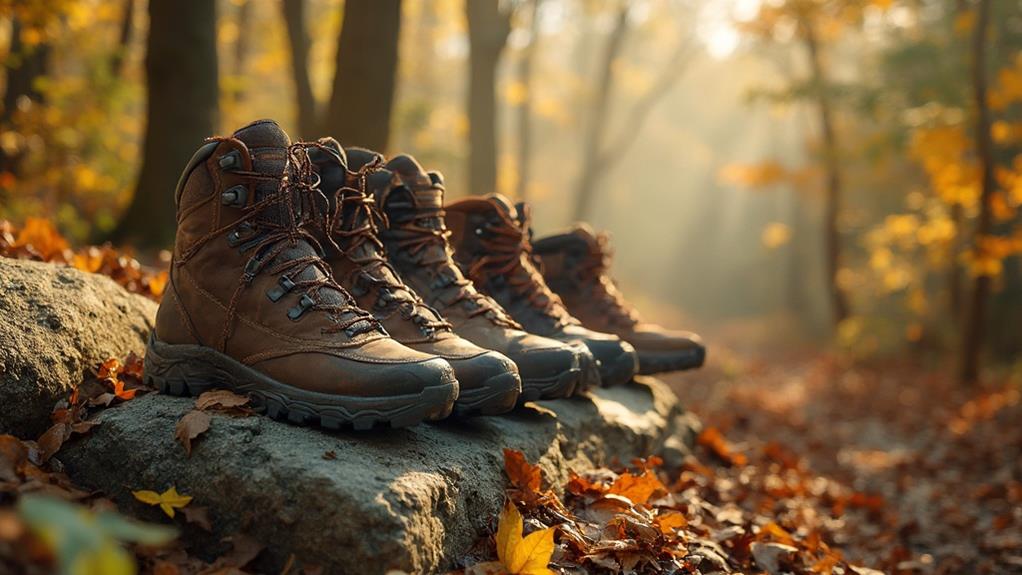
Why is selecting the right hiking footwear so important for new hikers? The right footwear is essential for guaranteeing comfort, support, and protection on the trail. New hikers must choose between various hiking shoe types tailored to different terrains. For rugged landscapes, sturdy walking boots offer the necessary ankle support and durability. Conversely, lighter trail-running shoes may suffice for well-maintained paths, providing flexibility and ease of movement.
Proper foot care begins with a correctly fitting shoe. Guaranteeing adequate room for toes helps prevent blisters and discomfort, crucial for maintaining foot health during hikes. Additionally, a proper break-in period is important to adapt the footwear to the hiker's unique foot shape, minimizing the risk of injury.
In terms of materials, waterproof and breathable options like Gore-Tex are recommended. These materials effectively keep feet dry in wet conditions while allowing moisture to escape, thereby preventing excessive sweating and discomfort. Gaiters can be a valuable addition, offering protection against debris, mud, and moisture, particularly in areas with dense foliage or unpredictable weather.
Complement your footwear with quality hiking socks that are moisture-wicking and cushioned. These provide additional comfort and blister prevention, integral components of extensive foot care in hiking.
Choosing the Right Backpack
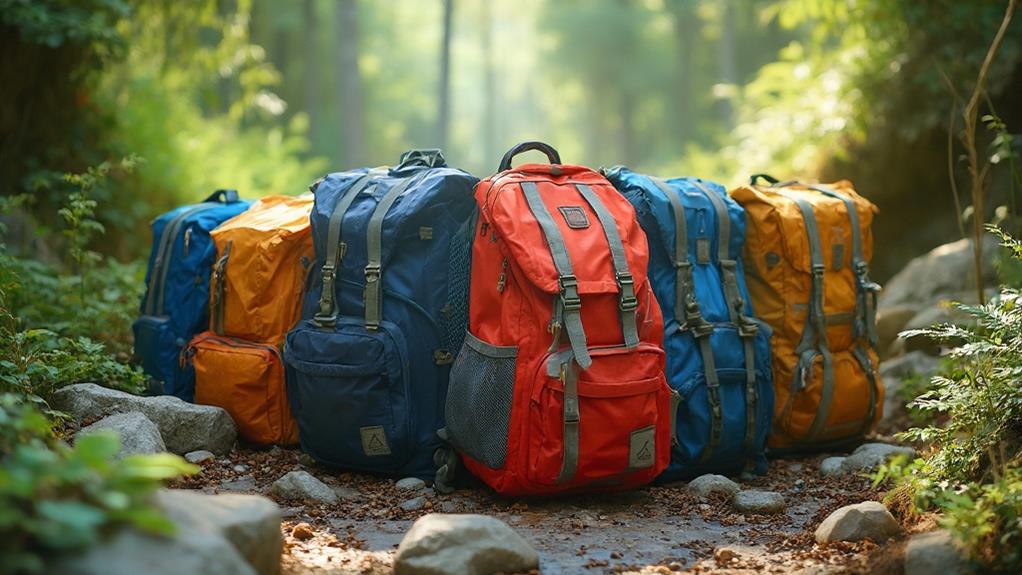
Selecting the right backpack is a critical step in guaranteeing a successful hiking experience, especially for new hikers. A well-chosen backpack offers comfort, functionality, and durability. For day hikes, a capacity of 18-30 liters is ideal, providing sufficient space for essentials like water, snacks, and an extra layer of clothing. Prioritize backpacks with adjustable straps, including padded shoulder straps and hip belts, to guarantee maximum comfort and support during prolonged treks. This adjustability is essential in distributing weight evenly, reducing strain on your back and shoulders.
When it comes to backpack materials, lightweight designs are preferable, ideally under 2 pounds, to minimize the burden during longer hikes. Additionally, select a backpack equipped with a hydration reservoir or water bottle pockets, guaranteeing easy access to hydration. Features like a rain cover and multiple compartments enhance organization and protect your gear from the elements.
Here's a quick comparison of key backpack features:
| Feature | Importance |
|---|---|
| Capacity (18-30 liters) | Crucial for carrying hiking essentials |
| Adjustable Straps | Provides comfort and weight distribution |
| Lightweight (<2 lbs) | Minimizes carrying effort |
| Hydration Compatibility | Guarantees easy access to water |
| Rain Cover & Compartments | Protects gear and aids organization |
Navigation Tools
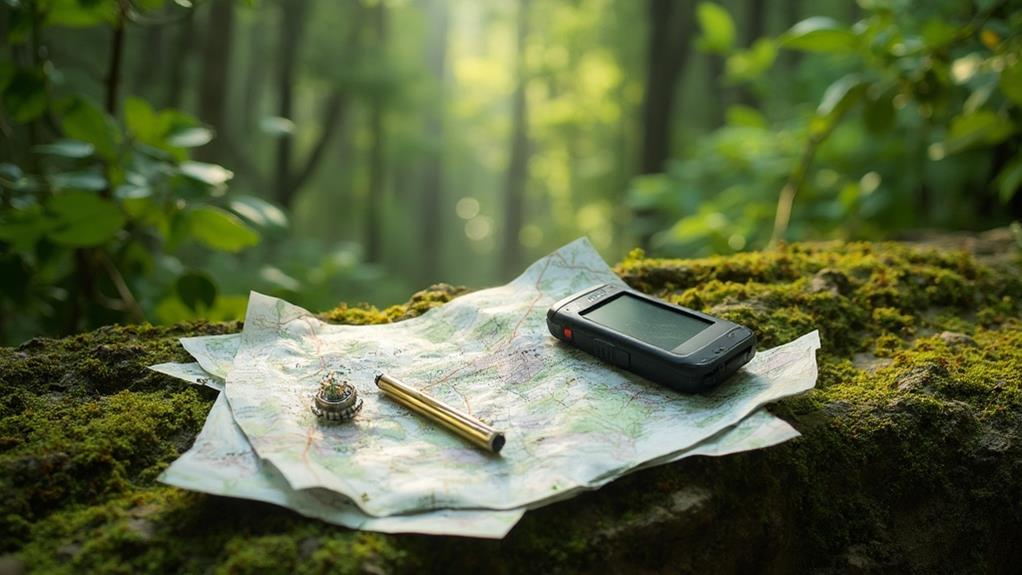
Having secured the perfect backpack, equipping oneself with reliable navigation tools is the next step for new hikers. Navigation tools are paramount in guaranteeing that you stay on the correct trail, especially in unfamiliar terrain.
While smartphone navigation apps like AllTrails and Gaia GPS offer real-time trail information and offline maps, relying solely on them can be risky due to potential battery failures or signal loss. Consequently, carrying a physical map is indispensable. Mastering map reading is essential, allowing you to interpret the landscape and understand your surroundings even when technology fails.
A compass is another fundamental tool, renowned for its reliability and independence from batteries. When combined with map reading, compass skills can greatly enhance your ability to navigate through challenging environments. Practicing these skills before setting out is imperative, as it guarantees you can efficiently orient yourself if needed.
For serious hikes, a dedicated GPS device, such as the Garmin GPSMAP 67, offers robust navigation capabilities. These devices are designed to endure harsh outdoor conditions, providing a dependable alternative to smartphones.
Ultimately, familiarizing yourself with each navigation tool's functions and limitations is crucial for effective navigation and guaranteeing your safety on the trail.
Layering Clothing
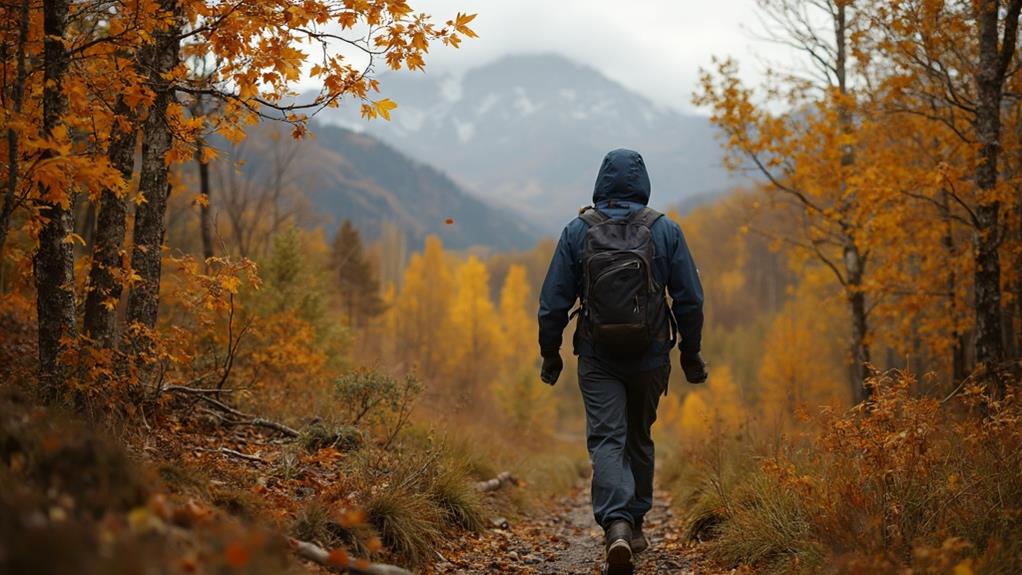
When starting on a hiking adventure, mastering the art of layering clothing is essential for maintaining comfort and safety in the face of changing weather conditions. The three-layer system provides a strategic approach to adapting to nature's unpredictability.
Begin with a base layer crafted from moisture-wicking materials such as synthetic fibers or merino wool. These materials efficiently manage perspiration, keeping your skin dry and reducing the risk of hypothermia. Avoid cotton, as it retains moisture and can quickly lead to chilling.
Transitioning to the mid layer, focus on insulation to retain body heat. Fleece jackets or down vests serve as excellent mid layer insulation options, offering warmth without unnecessary bulk. They can be easily adjusted to accommodate temperature fluctuations, making them indispensable in varying climates.
The outer layer, often referred to as the shell, should be both waterproof and windproof, with features like adjustable cuffs and ventilation. This layer shields you from rain and wind while allowing breathability, vital for maintaining comfort during intense physical exertion.
Food and Snacks
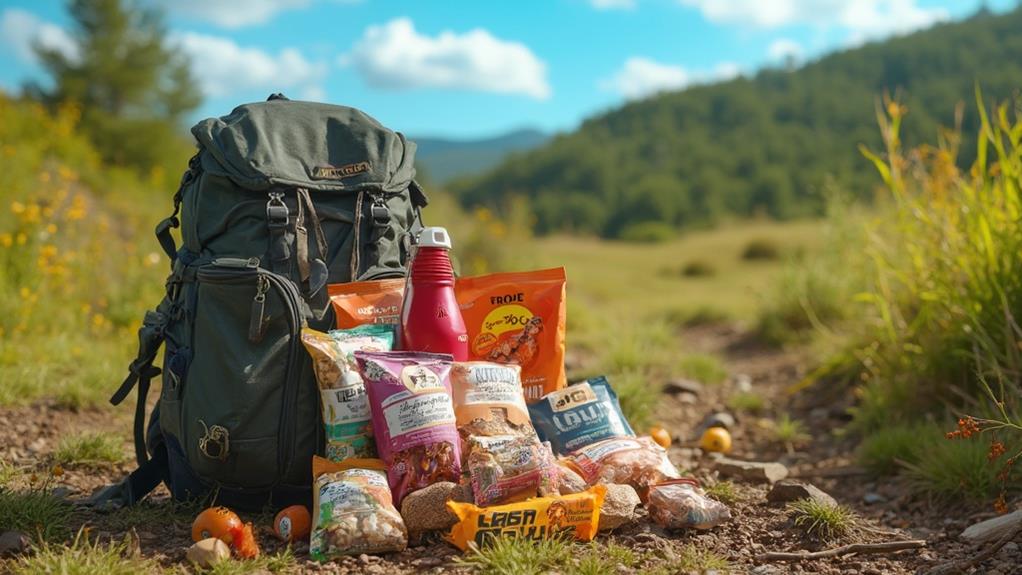
When starting on a hike, selecting the right food and snacks is essential to maintaining energy and stamina.
Quick energy sources like salted nuts, energy bars, and dried fruits provide immediate calories, while freeze-dried meals offer a nutrient-dense option without the burden of extra weight.
It's advisable to plan for a caloric intake of 100-200 calories per hour and to carry extra provisions for unforeseen circumstances, ensuring you remain fueled and ready for the trail ahead.
Quick Energy Sources
Maneuvering the trails as a new hiker requires more than just stamina and determination; it demands smart choices in nutrition to maintain energy levels throughout the journey. Energy bars are an excellent solution, offering the benefits of convenience and portability. Brands like Clif Bars and RXBARs are packed with carbohydrates and protein, making them perfect for maintaining sustained energy.
However, it's essential to diversify your quick energy sources with hiking snack alternatives that cater to different tastes and nutritional needs. Dried fruits, such as apricots, bananas, or apples, provide natural sugars and fiber, vital for sustaining energy without the need for elaborate preparation.
For those seeking a blend of flavors and nutrients, trail mix is an unbeatable choice. Combining nuts, seeds, and dried fruits, it offers a balanced mix of healthy fats, protein, and carbohydrates, ensuring long-lasting energy and satiety.
For a savory option, jerky—be it beef or turkey—provides a high-protein, lightweight snack that's easy to pack. Additionally, energy gels and chews, often favored by endurance athletes, deliver a rapid energy boost through easily digestible carbohydrates, ideal for tackling the most strenuous parts of a hike.
Nutrient-Dense Options
For hikers starting on their journey, the importance of nutrient-dense snacks cannot be overstated. Proper nutrient timing and snack variety are vital for maintaining energy and stamina on the trail.
Salted nuts offer a balanced mix of healthy fats, protein, and carbohydrates, making them an excellent choice for sustained energy. These compact snacks are easy to pack and provide a steady release of nutrients throughout your hike.
Energy bars such as Clif Bars or RXBARs are another essential for new hikers. Containing 200-300 calories and fortified with vitamins and minerals, they guarantee you maintain energy levels on longer treks. Their convenient packaging makes them a hassle-free option for quick consumption.
Dried fruits like apricots or cranberries are rich in natural sugars and fiber, delivering a quick energy boost and supporting digestive health.
For more extended hikes, freeze-dried meals are invaluable. With 300-500 calories per serving, they are lightweight and easy to prepare, ideal when cooking facilities are unavailable.
Incorporating electrolyte chews or tablets like NUUN can help replenish lost minerals, vital for hydration and recovery.
Hydration Systems
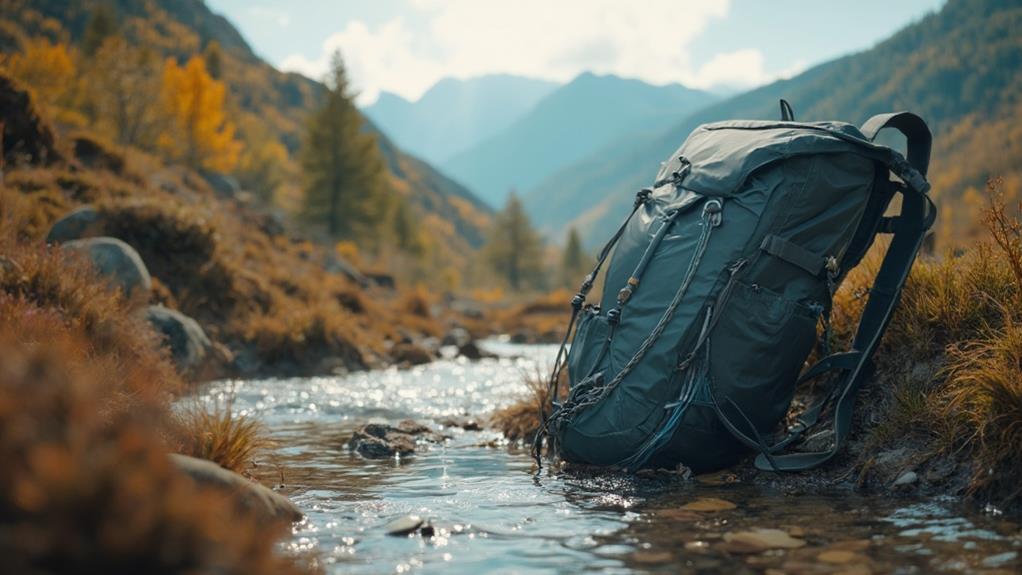
An essential component of any new hiker's gear list is a reliable hydration system, which can greatly impact your comfort and safety on the trail. The hydration benefits extend beyond mere thirst quenching; they play a vital role in preventing heat-related illnesses and reducing fatigue.
To guarantee you're adequately hydrated, it's advisable to carry a system that holds at least 1 liter of water, though many seasoned hikers prefer 2-3 liters for longer treks. Hydration tips include drinking approximately 0.5 liters per hour, adjusting for temperature and exertion levels.
Hydration packs with built-in bladders and drinking tubes offer the convenience of hands-free sipping while on the move, making them an ideal choice for sustained hikes. Alternatively, durable water bottles, such as Smartwater bottles, remain a lightweight option and can be seamlessly integrated with water purification systems, providing safe drinking in remote areas.
It's also wise to pair your hydration system with snacks, as consuming water without accompanying nutrition can lead to hypoglycemia, especially during strenuous hikes. Ultimately, selecting the right hydration system is pivotal in safeguarding your well-being and enhancing your hiking experience.
Environmental Responsibility
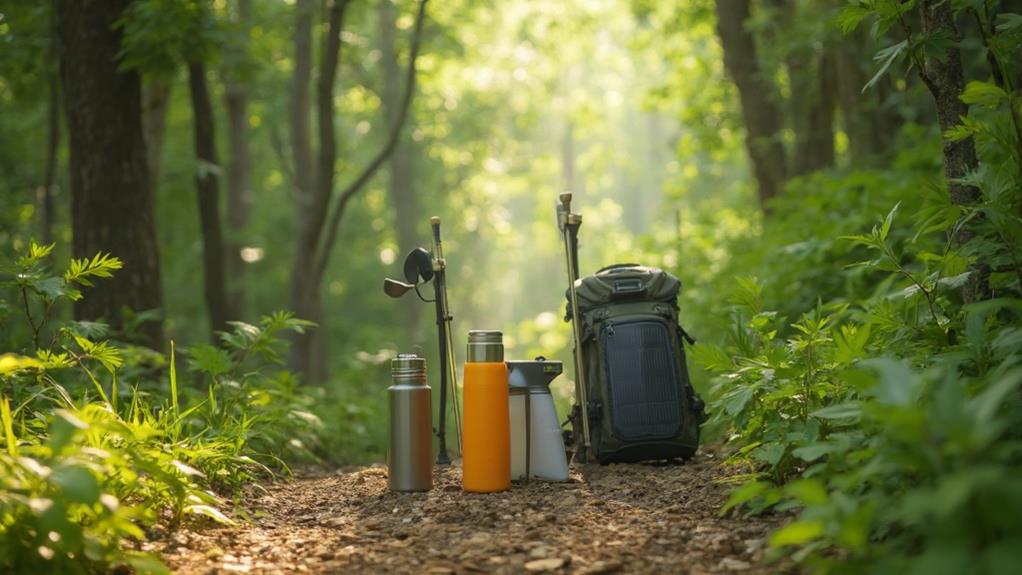
When commencing your hiking journey, it is imperative to integrate environmental responsibility into your outdoor practices by adhering to Leave No Trace principles, which include packing out all trash and respecting wildlife habitats.
Straying from designated trails can contribute to habitat destruction and trail erosion, with research indicating that up to 80% of hikers unintentionally cause environmental harm.
Leave No Trace
How can new hikers guarantee their adventures are environmentally responsible? By embracing the Leave No Trace principles, hikers can notably minimize their ecological footprint.
These guidelines are fundamental for responsible hiking, advising outdoor enthusiasts to pack out all trash, stay on designated trails, and avoid disturbing natural flora and fauna. Carrying a small trash bag is practical and essential, as plastic pollution claims the lives of 1 million birds and over 100,000 marine animals annually. Ensuring proper waste disposal prevents harm to wildlife and maintains the pristine condition of natural landscapes.
Moreover, adhering to Leave No Trace principles preserves these areas for future generations. Studies highlight that well-managed natural spaces are critical for sustaining biodiversity and ecosystem health. By staying informed and practicing these guidelines, hikers contribute to the conservation of these important resources.
Education plays a key role in this endeavor. Sharing knowledge about Leave No Trace practices can lead to notable improvements in trail conditions.
Remarkably, 75% of hikers are willing to adjust their behaviors when made aware of the environmental impacts of their activities. Consequently, new hikers can lead by example, fostering a culture of environmental stewardship and responsibility in the hiking community.
Respect Wildlife Habitats
Preserving the beauty and integrity of natural landscapes extends beyond responsible waste management; it encompasses safeguarding wildlife habitats as well. For new hikers, understanding the principles of wildlife safety and habitat conservation is essential.
Start by adhering to designated trails, which notably reduce habitat destruction and minimize erosion. These trails are carefully planned to protect local ecosystems and the creatures residing within.
Maintaining a respectful distance from wildlife is another important practice. This not only guarantees your safety but also prevents animals from becoming accustomed to human presence, which can disrupt their natural behaviors.
Feeding wildlife, for instance, can lead to dependency on human food sources, altering their foraging habits and potentially harming their health.
Proper waste disposal is critical. Utilize trash bins when available or carry out all waste to prevent litter from polluting habitats and endangering wildlife.
Educating yourself about local wildlife regulations and guidelines is also necessary, as these are designed to protect endangered species and sensitive areas.
Consider engaging with conservation efforts by participating in clean-up events or volunteering with organizations dedicated to preserving wildlife habitats.
Your proactive involvement contributes to the ongoing protection of these precious natural environments.
Basic First Aid Supplies
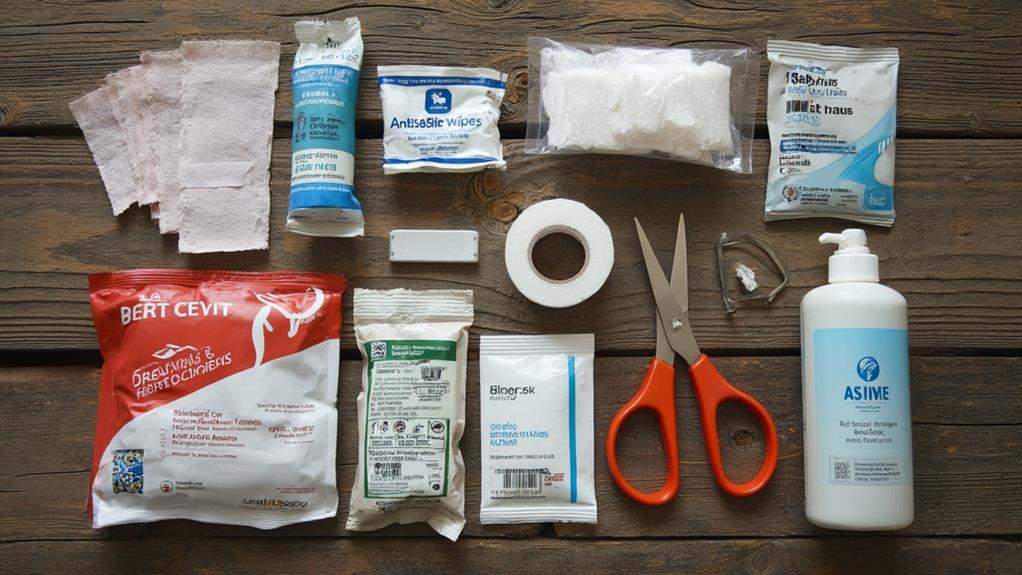
Preparation is the cornerstone of a safe and enjoyable hiking experience, and a well-equipped basic first aid kit is indispensable for addressing common trail mishaps. First aid kits designed for hiking should be lightweight yet thorough, focusing on injury prevention and treatment.
Essential items include adhesive bandages in various sizes, antiseptic wipes or solutions, and gauze pads, all of which are essential for treating minor cuts and scrapes encountered on the trail.
Blister care supplies are important, as foot injuries can quickly turn a pleasant hike into an uncomfortable ordeal. Including blister pads and leukotape in your kit will help prevent and treat blisters, ensuring you maintain mobility and comfort on longer hikes.
Tweezers are another key tool, useful for removing splinters or ticks, which are common nuisances in many hiking areas. A small roll of duct tape offers versatility, serving multiple purposes from gear repair to providing added support for injuries or blisters.
Additionally, customizing your first aid kit based on personal needs—such as including allergy medications or even a dog-friendly kit if hiking with pets—enhances its effectiveness. By thoughtfully assembling your first aid kit, you can greatly enhance your hiking safety and enjoyment.
Emergency Equipment
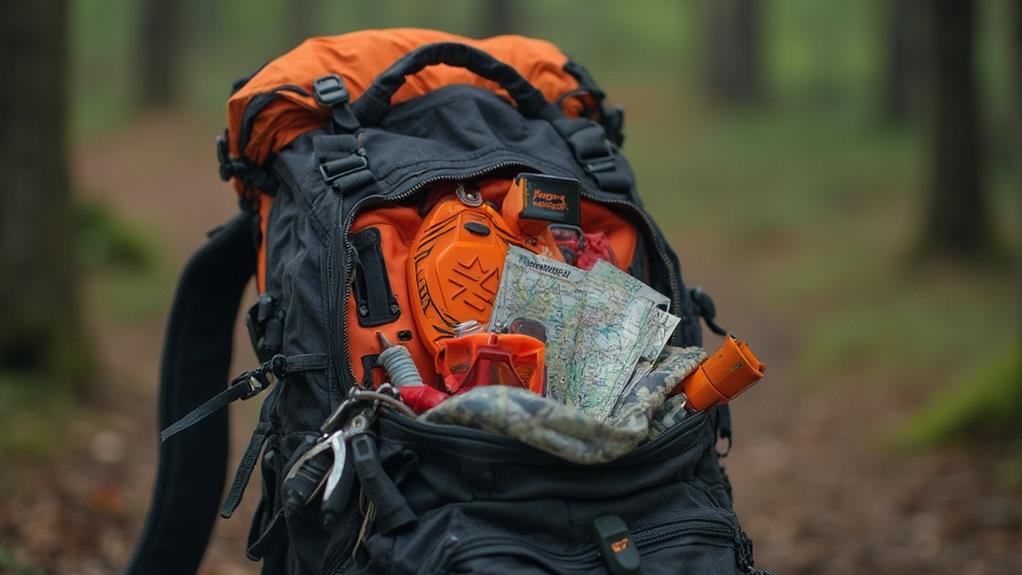
When venturing into the great outdoors, what essential items should you carry to guarantee your safety in unforeseen situations? Among the foremost tools is an emergency whistle, critical for signaling distress. Available in various whistle types, such as pea-less or dual-tone, these devices assure your calls for help are heard from afar. Their compact size makes them an indispensable addition to any hiker's gear.
Equally important is a lightweight emergency bivvy or Mylar blanket. Weighing under 4 ounces and costing approximately $10, these items offer significant bivvy benefits by providing life-saving warmth and shelter in survival scenarios. Their compact design allows them to fit easily into any backpack, making sure you are prepared for unexpected overnight stays in the wilderness.
Additionally, a first aid kit with essentials like bandages, antiseptic wipes, and tweezers addresses minor injuries effectively.
For fire-starting capabilities, a compact fire starter like the SOL Fire Lite Fuel-Free Lighter is recommended. This multifunctional tool not only ignites fires but also functions as a flashlight, weighing in at under 2 ounces.
Weather Preparedness
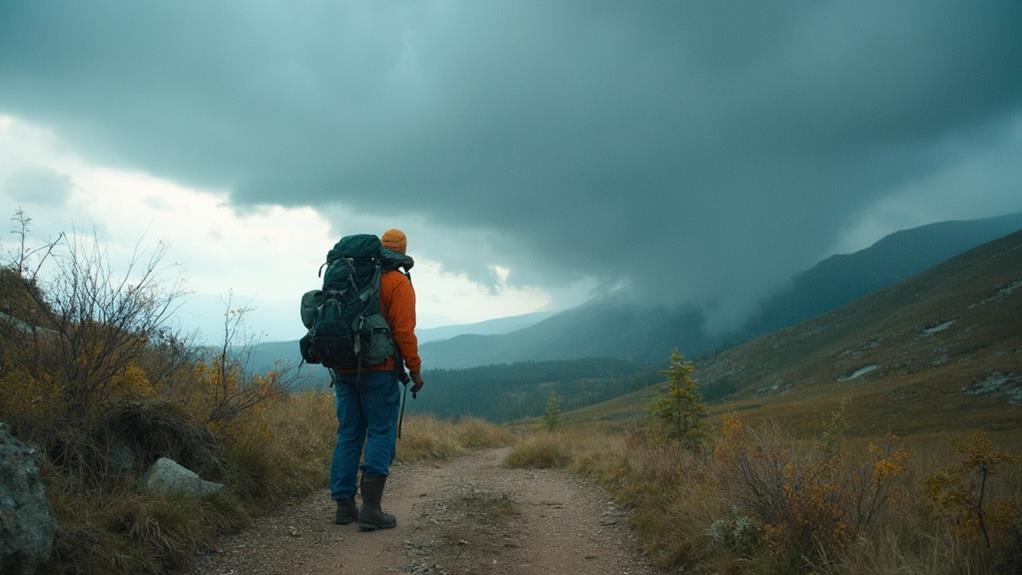
Weather preparedness is a critical aspect of hiking that guarantees your safety and comfort across diverse environmental conditions.
Implementing a strategic layering system is essential to efficiently manage temperature fluctuations, providing the flexibility to add or remove moisture-wicking base layers, insulating mid-layers, and waterproof outer layers as needed.
Additionally, equipping yourself with waterproof essentials, such as a high-quality rain jacket and weather-resistant gear, will keep you dry and protected.
Preparing for seasonal variability with items like an emergency bivvy or mylar blanket assures readiness for unexpected weather extremes.
Layering for Temperature Changes
Maneuvering the unpredictable nature of outdoor environments, a hiker's best defense is a well-considered layering strategy. Central to this approach is the three-layer system, which guarantees ideal temperature regulation and comfort.
The base layer is pivotal for moisture management, effectively wicking sweat away from the skin. Opting for fabrics such as synthetic or merino wool over cotton is essential, as these materials dry quickly and prevent chilling.
Insulation materials in the mid-layer, such as fleece or down jackets, serve to trap body heat, providing warmth during cooler conditions. Finally, the outer layer should be both breathable and resistant to elements like wind and light rain, making sure that sweat vapor can escape while keeping external moisture at bay.
When assembling your hiking attire, consider the following essential items:
- Base Layer: Choose moisture-wicking fabrics like synthetic or merino wool.
- Mid-Layer: Insulate with fleece or a lightweight down jacket for warmth.
- Outer Layer: Make certain it is breathable and shields against wind.
- Avoid Cotton: It retains moisture, leading to potential chilling.
- Pack Extra Layers: Always carry additional clothing for unexpected temperature drops.
Waterproof Essentials for Rain
To tackle the challenges posed by rain during hikes, investing in waterproof essentials is critical for both comfort and safety. A quality waterproof jacket, such as the Patagonia Torrentshell 3L, is indispensable. This jacket provides robust protection against rain while maintaining breathability, which is essential for moisture management on the trail.
Equally important are waterproof over-trousers, designed to keep your legs dry. Choosing a pair with adjustable cuffs and ventilation options will enhance both comfort and mobility, allowing you to navigate wet conditions with ease.
Rain gear for your backpack is also important to guarantee your belongings remain dry. Lightweight, packable rain covers are an effective solution to prevent water from seeping into your gear during sudden downpours.
For footwear, waterproof options like Gore-Tex hiking boots are necessary. These boots shield your feet from moisture, reducing the risk of blisters and cold-related discomfort.
In terms of clothing, opt for moisture-wicking base layers made from synthetic materials. These layers dry quickly and regulate body temperature even when wet, unlike cotton, which can retain dampness.
This thorough approach to moisture management will greatly enhance your hiking experience in rainy conditions.
Adapting to Seasonal Variability
As hikers navigate the diverse challenges posed by seasonal variability, strategic preparation becomes essential to guarantee a safe and enjoyable experience. Understanding the impacts of temperature fluctuations and seasonal trails is vital for adapting to ever-changing weather conditions.
Layering clothing is a fundamental strategy; start with a moisture-wicking base layer, add an insulating mid-layer, and top it off with a waterproof outer layer. This combination effectively manages both temperature and moisture, allowing for quick adjustments as conditions shift.
Before starting on any hike, always check the weather forecast to anticipate potential rain, wind, or extreme temperatures, especially in regions like mountainous or coastal areas where weather can change rapidly.
To further prepare for these fluctuations, consider the following gear essentials:
- Moisture-wicking base layer: Keeps sweat away from your skin.
- Lightweight, packable rain jacket: Easily stored and essential for sudden downpours.
- Insulated clothing: Necessary for retaining body heat during cooler spells or rest periods.
- Sun protection and hydration: Key during summer hikes when trails are exposed.
- Trail conditions awareness: Seasonal trails may be muddy in spring/fall or dusty in summer.
Recommended Gear Brands
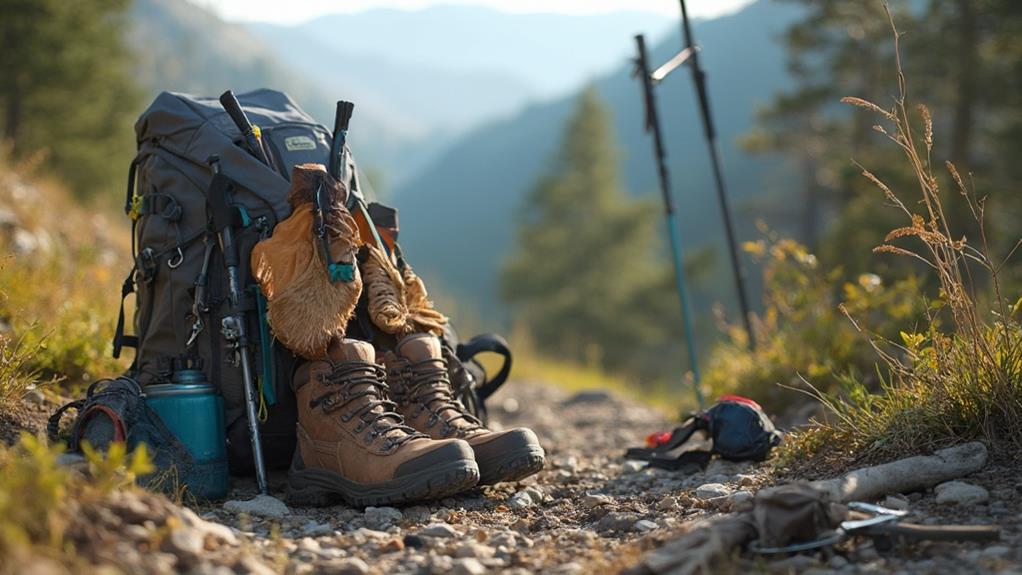
Starting on a hiking adventure requires not only enthusiasm but also the right gear to secure safety and comfort. Selecting gear from reputable brands assures reliability on the trails. Patagonia is an exemplary choice, offering high-quality, eco-friendly outerwear like the Torrentshell rain jackets and Down Sweater Hoody, perfect for unpredictable climates.
For gear maintenance tips, regularly wash and reapply water-repellent coatings to extend the lifespan of these items.
In terms of footwear, Merrell's Moab series stands out with its durable, waterproof options and superior traction, ideal for diverse terrains. For a brand comparison insight, while Salomon's OUTline series is also renowned for performance footwear, it excels in comfort and support, making it suitable for varied hiking conditions.
Backpack selection is critical, and Osprey's Hikelite series is designed for comfort and ventilation, accommodating both day hikes and extended treks.
Meanwhile, Black Diamond's Alpine Carbon Cork trekking poles offer lightweight durability, perfect for rugged trails. When comparing, their poles are particularly noted for endurance on challenging terrains.
Investing in trusted brands assures not only the quality but also the longevity of your hiking gear, enhancing your outdoor experience.
Frequently Asked Questions
What Hiking Gear Is Essential?
Essential hiking gear includes supportive hiking footwear to prevent blisters and guarantee stability, and reliable navigation tools, such as a map and compass or GPS device, to safely guide your journey and prevent getting lost in unfamiliar terrain.
What Do You Need for Your First Hike?
For your first hike, prioritize hiking preparation tips: wear layered, moisture-wicking clothing, sturdy footwear, and pack essentials. Adhere to trail etiquette basics by staying on marked paths, respecting wildlife, and leaving no trace of your presence.
What Is a Good First Aid Kit for Hiking?
A good first aid kit for hiking prioritizes first aid essentials like adhesive bandages, antiseptic wipes, and tweezers. Including versatile items such as duct tape and emergency blankets enhances hiking safety by addressing minor injuries and unexpected conditions effectively.
What Is Something a Hiker Should Always Have Before Going on His First Hike?
Before initiating a first hike, a hiker should prioritize hydration strategies, ensuring adequate water supply and accessibility. Additionally, understanding trail etiquette is essential, promoting safety and respect for nature and fellow hikers, enhancing the overall hiking experience.
Conclusion
To sum up, equipping oneself with the appropriate gear is imperative for ensuring a safe and enjoyable hiking experience. Consideration of hike types, itinerary planning, and safety measures form the foundation of preparation. Selecting suitable footwear and backpacks enhances comfort and efficiency. Inclusion of basic first aid supplies and emergency equipment is essential for unforeseen circumstances. Weather preparedness further safeguards against environmental challenges. Prioritizing quality gear from reputable brands will contribute greatly to the hiker's overall experience and security.